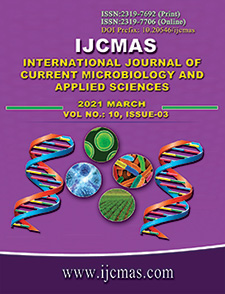


 National Academy of Agricultural Sciences (NAAS)
National Academy of Agricultural Sciences (NAAS)

|
PRINT ISSN : 2319-7692
Online ISSN : 2319-7706 Issues : 12 per year Publisher : Excellent Publishers Email : editorijcmas@gmail.com / submit@ijcmas.com Editor-in-chief: Dr.M.Prakash Index Copernicus ICV 2018: 95.39 NAAS RATING 2020: 5.38 |
Brinjal or eggplant is the fourth most important vegetable crop in India in terms of production; India being its second highest producing country with 23.7% of world’s total share. Collar rot disease is proving to be a constraint for brinjal production with yield losses upto 30%. The pathogen Sclerotium rolfsii is able to attack all stages of the crop and is difficult to manage. A study was undertaken to investigate the efficacy of botanicals and bioagents in the management of the disease. The field experiment laid out in Randomized Block Design in the Department of Plant Pathology, SHUATS, Prayagraj during Rabi 2019-2020, evaluated the role of botanicals and bioagent on different growth and yield parameters of brinjal crop. Maximum plant height at 30 DAT (22.10 cm), 60 DAT (32.24 cm) and 90 DAT (40.50 cm), maximum number of branches at 30 DAT (3.53), 60 DAT (6.2) and 90 DAT (8.8), and maximum number of leaves at 30 DAT (20), 60 DAT (32.87) and 90 DAT (49.53) was obtained with seedling root dip treatment of Trichoderma viride +castor oil. The Trichoderma viride +castor oil treatment in combination, also recorded disease incidence of 0% at 30 DAT and 60 DAT, and minimum disease incidence at 90 DAT (4.17%), and the highest yield (0.575 Kg/plant) as compared to control.
 |
 |
 |
 |
 |